-
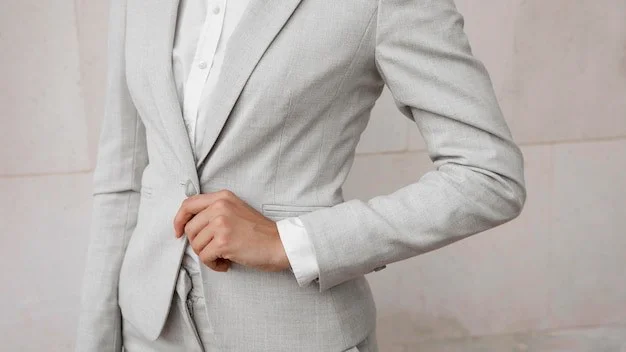 How Much Should Custom Suits Cost: A Pricing Guide
How Much Should Custom Suits Cost: A Pricing GuideMany people think of custom tailoring as quite an expensive hobby. It's a significant investment, often costing over $2,500. The question arises here: How much should a custom suit cost? Well, it depends on the choice of fabric and several other factors.
Custom suits are now in high demand because of their sharp tailoring and professional appearance. Whether for weddings or business, a well-tailored suit is essential. Many tailors will offer different budgets, but what about the fabrics, craftsmanship, customization, and all?
With our experience in custom tailoring, you will get professional insights into the market. Take advantage of this blog and learn the factors that contribute to a great suit.
How Much Should a Custom Suit Cost?
Custom clothing is about your tailor getting your measurements to stitch your suit. The most popular custom clothing known is made-to-measure. MTM clothing is a power source for online clothing manufacturers. The stores or manufacturers have a custom specialist to measure your suit in person. However, a custom specialist will guide one of your closest people to get your measurements for the online process.
A stylist will insert all your measurements into the software to generate the patterns or blocks for your suit.
Whether through in-person or made to measure suits online services, a well-made custom suit typically costs between $900 and $3,500. A basic quality suit will cost you from $800 to $1499, whereas a very good suit will range from $1999 to $2999. All women's and men's custom suit costs will differ according to patterns, style, and clothes fabric.
Key Factors Influencing the Cost of Custom Suits
Custom suits are way more intricate than ready-made ones. However, there are a lot of factors which make it preferable to others.
Quality Fabric Selection
The basic factor that influences custom-suit pricing is the selection of fabric. No matter the type of fabric you opt for, like Italian wool, silk, polyester, or linen, your fabric selection will affect the suit's quality and cost. If you opt for cashmere, tweed, wool, or silk, you have to pay for their texture and comfort, which brings you durability.
Kutetailor's fabrics bring you luxury as they are in touch with the best fabric suppliers. Sadly, not everyone can afford luxury fabric, so a broader range of market offers you multiple options like wool-polyester blends.
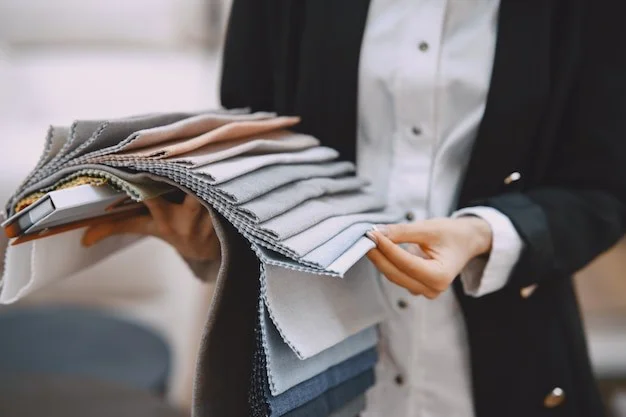
Level of Customization
Custom suits without customization are not possible. Basic customization will not cost you a high price tag as it includes fabric selection, style, and slight adjustments. On the other hand, intricate customization will cost you a lot. It includes pattern selection, stitching details, lining details, resources, time delivery, and much more.
Usually, manufacturers offer customization packages. It ranges from entry-level, mid-level, and premium packages. Each package comes with detailed customization and charges.
Labor and Craftsmanship
With fabric and customization, craftsmanship also affects the cost of custom suits. Professional tailors who stitch suits from scratch demand high labor, which ultimately increases the custom suit cost. There must be a balance between craftsmanship, affordability, and quality.
Production
Manufacturers play a crucial role in the pricing and quality of custom suits. Professional manufacturers cost high for their labor, resulting in quality and standard work. However, outsourcing production will reduce manufacturing costs. This benefit comes with quality loss and longer delivery time. Transparent communication with the tailor is essential to increase the trust between seller and buyer.
Extra Detailing
Custom suits require extra detailing as enhancers. The basic design of the suit will look good. However, extra detailing and work enhance the look and price. But you have a free hand to ask for extra details about your suit.
For example, you can go for enamel buttons instead of plastic ones. Handmade lapel buttonholes look good. Choose the artistic lining over the normal ones. Fine silk fabric is more expensive than a cotton lining.
Therefore, the cost of a custom suit cost is your budget and fabric selection. The more high-quality stuff you choose, the more you pay for the look.
Market Positioning and Pricing Strategy
For custom suit startups, market positioning is a brand image in public and any marketplace. You need to understand the market positioning before quoting the rates.

Understanding Your Market Position
Analyze your brand's end goal, whether it offers luxuries and aims towards accessibility of products. Your market position must reflect your pricing and target your audience. If you offer luxury positioning, your customers look forward to premium quality products, exclusive details, and high-end craftsmanship.
Meanwhile, mid-range positioning offers quality products with flexible pricing. It's a game of balancing the best one in the market with competitive rates. The budget positioning brand will focus on affordability. They target the MTM suits where there's not much customization and satisfy the customer needs at affordable prices.
Developing a Pricing Strategy
Once you figure out your brand's market position, it's time to create your pricing strategy. You can create one of these pricing strategies for your brand.
Premium pricing requires higher quality products, personalized service, intricate detailing, and exclusive designs. It creates the exclusivity of the brand for customers.
Meanwhile, competitive pricing makes you run the race while charging the market prices. It's best for mid-range brands that offer something additional while focusing on affordability. It can be anything: free delivery, active customer support, professional guidance, etc.
Penetration pricing is for brands that enter a new market or startups. So, to stay out, they offer low prices like discounts or buy-get-one offers. The key point is to attract customers and build a brand.
In contrast, Value-based pricing is for brands with no price tags and flexible rates. Through this, they'll know what and how much customers will pay more.
Once you figure out your brand's market positioning and pricing strategy, it's time to communicate them to your partners.
Tips for Maximizing Profits
Being a MTM clothing brand, it's essential to maximize the profit of custom suits. We offer a few tips to help you maximize profit in a tailor's business.
Sourcing Efficiently
Trustable suppliers are essential if any brand wants to maximize its custom clothing business. To offer consistent quality, manufacturers will need quality material at competitive prices with no extra cost.
Build strong relationships with suppliers for exclusive material supply and communicate regularly. Bulk purchases the stock for additional discounts. Negotiate the prices and pay upfront to build trust. Head to multiple suppliers to avoid inconveniences and have the needed stock anytime.
Streamlining Operations
Once you have multiple suppliers, it's time to streamline your operations. It will increase efficiency while minimizing the initial cost with the benefit of high profit. Utilizing digital platforms is the easiest way to achieve this goal. Establishing an online order system will facilitate transparent communication for your customers, vendors, and businesses. Automate the order process system to reduce errors and suit real-time progress.
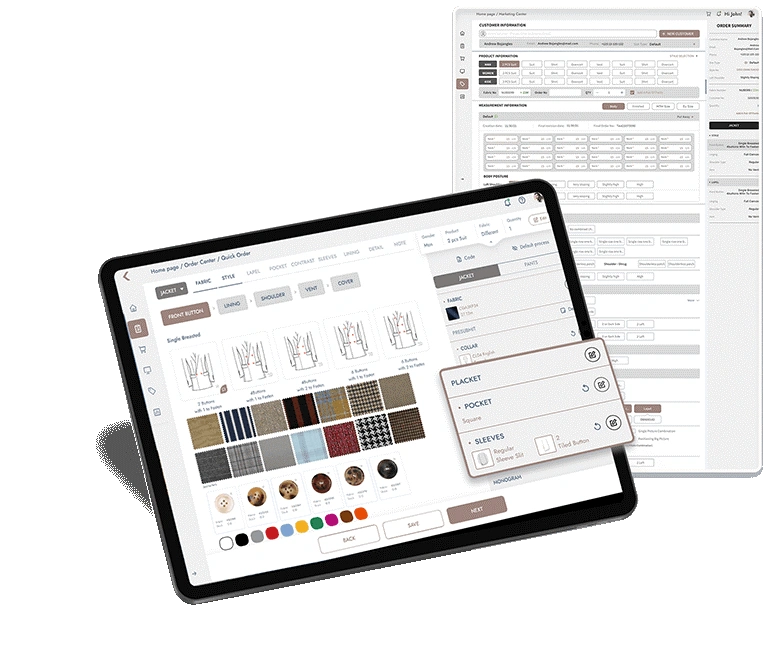
Keep track of material usage, stock levels, and timely supply reorders by installing inventory management software. This way, the company won't face overstocking and stockouts. Automate the process of customer care and invoices to save time and resources. It'll help you focus on productivity and profits.
Cooperating with a Reliable Manufacturer
A reliable manufacturer is as important for the MTM clothing brand as the supplier. Fortunately, Kutetailor brings the brand standard that meets clothing needs. We are a one-stop customization platform with R&D designers who create trendy design suits for every season.
The custom suits will meet all legal standards like GB/T 2664-2017 and FZ/T 81007-2012. The team of professional tailors and imported machinery ensure the high quality of custom suits. Kutetailor offers MTO and MTM clothing. Whether the requirements for customization in men's and women's clothing or the need for formal, smart, and casual clothing, we are just one click away.
Kutetailor has also done all the legwork to offer traditional Chassidish wear. We are connected with reputable design startups, business brands, and distributors to serve high-level craftsmanship.
FAQs
Are the bespoke suits and MTM suits the same?
Bespoke and made-to-measure (MTM) suits differ primarily in their construction process. Custom suits have exclusive designs that get stitching and cutting from scratch. Meanwhile, tailored suits have cutting and stitching with the client's body type in the existing pattern or design.
How much should a custom-made suit cost?
Nobody can quote the exact amount of custom-made suits. However, it can range from $900- $3500, depending on your choice of fabric, pattern, styling and customization. Sometimes, the manufacturers' location also varies the cost of custom-made suits.
What's the reason behind the high cost of custom suits?
Manufacturing and craftsmanship cost the major portion of custom suits. It requires expertise in designing, hand stitching, and intricate detailing, which costs the suit more than the machine made.
How much should a men's custom suit cost?
A men's suit has many variables to consider when pricing. A nice fit tailor men's custom suit will cost you $1500, including nice fabric, intricate detailing, and extras.
Which fabric makes the suit more expensive?
Polyester and rayon are cheap fabrics that blend cotton and wool. They make the suit cheap and give it a shiny look. High-end suits often feature fabrics like super 150s wool, cashmere, or silk blends, which cost significantly more than polyester or rayon blends.
MORE 2024-08-30 -
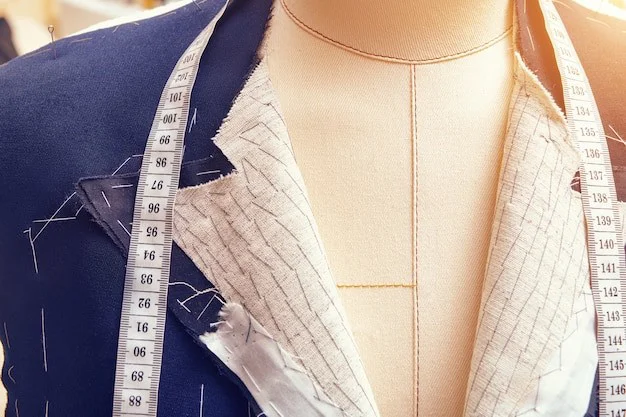 Traditional and Online Ways for Measuring Custom Suit Jackets
Traditional and Online Ways for Measuring Custom Suit JacketsEvery stitch and detail of a custom suit jacket perfectly reflects your body curves. But this level of achievement comes with accurate measurement. And no one wants to spoil their look by wearing a loose and baggy suit or tuxedo. Here comes the moment of realization of how to measure for a suit jacket. Well, if you opt for the tailor, it will be an in-person job. If you want to buy online, you will have to use online measuring apps.
Today's digital world is evolving with every day. It combines traditional measuring methods with online apps to make their dream a reality. Now, you can get your suit measurements without leaving the house. Innovative measuring apps and 3D technology are now a reality. But does this simplicity of made to measure suits online result in an ideal fit?
Traditional methods have skilled tailors and online methods reshape custom tailoring. From basics to how to measure a man for a suit jacket, we have got you covered.
Traditional Measuring Techniques for Custom Suit Jackets
For centuries, traditional measuring ways have been used for custom suit jackets. Professional and skilled tailors measure the person's body and utilize their hands-on skills for a personalized fit. For you, Kutetailor has 20+ imported machines that manufacture custom suit jackets. It's better to head to a professional tailor for measurement. But if you want to do it on your own, learn how to measure a suit jacket for size.
Essential Measurements for a Custom Suit Jacket
- Chest - Snug the measuring tape at the fullest area of the chest, which lies around the lines of the nipples. Take the measurement, ensuring the tape is at a level from front and back.
- Waist - Measure the narrowest part of the waist, a few inches over your navel. Leave room for breathing.
- Hip - Measure the broadest area of the hip, ensuring the tape is in line with the floor.
- Shoulder Width - Put the tape on one shoulder's back and measure it to another shoulder's endpoint.
- Sleeve Length - Stretch your arm a little to measure the starting point of the shoulder bone to the wrist.
- Arm Length - Extend the arm at an angle of 90, measuring from shoulder point to elbow's tip.
- Back Length - Measure the distance between the base of the neck and the pant's waistline.
- Jacket Length - First, choose the preference for a long or short jacket length. Measure the distance between the base of the neck to the point of the thigh as your desired length.
- Biceps - Measure the broadest portion of the upper arm, usually the center part of the elbow and shoulder.
- Wrist Length - Snug the tape around the wrist and measure the length.
A million-dollar advice for accurate measurements is to ensure the correct and straight posture of the client. Also, ensure the measuring tape is not too tight and confirm measurement twice for accuracy.
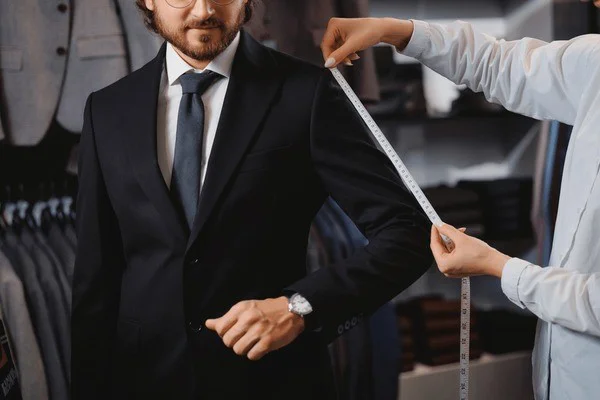
Common Mistakes to Avoid
While measuring the custom suit jacket for size, the tailor or person recording the measurement makes a few mistakes. We gather that list of mistakes you should consider during the body's measurement.
- Inaccurate Tape Placement - Sometimes, the tailor places the measuring tape too tight or loose, leading to short or lengthy measurements. Ensure the tape is snug and not tight during the measurements.
- Incorrect Posture - Usually, the client's posture is not straight, which causes the wrong measurements. Poor posture, puffing out the chest, and bending structure will cause loose or tight final results.
- Rushing the Process - Hand-based measurements are very time-consuming. So, many tailors rush over the process to wind up the measurements quickly. Ensure that every measurement is taken by the tailor and in a calm way. Confirm measurements twice.
Innovative Online Measuring Methods for Custom Suit Jackets
Many online measuring methods are popular in the market, which makes custom-suit jacket measurement easy. Here, we will discuss how to measure a man for a suit jacket online.
Online Measuring Tools
- Mobile Apps - Many companies provide their clients with mobile apps that help them with measurements. The apps offer interactive elements, tutorials, and detailed guides.
- Camera-Based Apps - Apps also come with smart cameras. The camera measures the body dimensions once you pose the way it asks. Your pictures and measurements will be taken from multiple angles. For example, Choozr takes your body dimensions from multiple angles.
- Digital Templates - very few apps offer digital templates for client guides. The template shows where and how to put the measuring tapes on your body for measurements.
- 3D Body Scanners - Many companies offer 3D body scanners that measure your body from multiple dimensions. It has advanced scanners installed that measure each length very precisely. 3DLOOK is an app that uses AI technology for body measurements.

Reliability of Online Methods
Most of the apps that cover different body dimensions are reliable. Many apps come with real-time feedback and advanced features that record accurate lengths. Apps provide interactive guides that help the user record the dimensions more accurately. However, camera-based apps might affect the results due to light and camera-resolution factors. Mobiles with good camera quality give reliable results.
3D body scanning apps are exact and offer detailed guides. They have a digital body model in apps that capture accurate measurements. Meanwhile, the 3D scanners might fluctuate the results with client posting and other factors like calibration issues. Therefore, learn how to measure a suit jacket for size in depth for accurate results.
Integrating Traditional and Online Measuring Methods
Traditional measuring methods are time-consuming, so tailors are combining traditional and online methods of measurement. It helps them save time and gives accurate results that lead to a fitted suit jacket. Here's a guide on how to measure for a suit jacket using both ways.
Start taking measurements of the body using Online measurement tools. Download any app and read its step-by-step guide for recording dimensions. Follow the tutorial and record the major lengths, such as chest, waist, shoulder, and sleeve widths. Enter the data and wait for the draft fit result.
Now, head to the nearest tailor and let him verify your measurements. Your online data will be verified using the hands-on method of suit measurement. The tailor will make the necessary adjustments and create the initial piece for you. Try the garment and let the tailor know for final adjustments. You can ask your tailor for further customization and details in your suit jacket.
This process will let you build trust in the online apps whether they give accurate readings for a fitted custom suit jacket or not. Give your tailor and app feedback once they give you your desired results.
Future Trends in Measuring for Custom Suit Jackets
Advances in 3D Body Scanning
The field of 3D body scanning technology is upgrading day by day. It's going to break records of previous data and will offer precise readings of body measurements. They will produce digital images of the body wearing the fit with specific lengths and sizes. Such scanners are still one click away from download, and their easy access makes them more validated in this era.
AI Enhancement Tools
Measurements and predictions will take a drastic upgrade in measurements because of Artificial Intelligence. Within seconds, AI can interpret your body shape, size, and lengths, which you can further use for custom jackets and suits. The feedback and real-time editing features ensure that you can personalize the fitting and enhance the experience.
Wearable Measurement Devices
Custom suit measurements bring new technology into the market, which is wearable measurement devices. These devices will record your real-time data and measurements through the installation of advanced technology. Belts, sensors, or cloth-integrated devices can save your movements. It's one of the most convenient and comfortable ways of making the measurement of a custom suit jacket easy and precise.
Final Thoughts
Wearing a fitted custom suit jacket is essential if you're heading to any event. Kutetailor makes it easy for you as we offer an easy ordering system with traditional and online measuring systems. We provide fitted suits for men and women in high-quality fabric. The installation of 20+ machines will stitch your custom suit jackets and offer you LDP and DDP payments based on your preferences. Consult our skilled designers and tailors to construct the final results of your clothing.
FAQs
How do you measure the size of your suit jacket?
A fitted suit matters for a personality and impression. Every suit comes in a size that has a letter and number. The number indicates the chest size, whereas the letter indicates the jacket's overall length. This is how you measure a man's custom suit jacket size.
How can anyone measure himself through camera-based apps?
Camera-based apps come with video tutorials that will record your dimensions automatically. It would be best if you had a good camera resolution and lighting to record the accurate measurements for a custom suit.
How does a tailor take measurements, and how can I make a fitted suit for myself?
Professional tailors take your measurements of every small detail so that you will not face any inconvenience. With the proper measurements, you can create a fitted suit for yourself.
MORE 2024-08-28 -
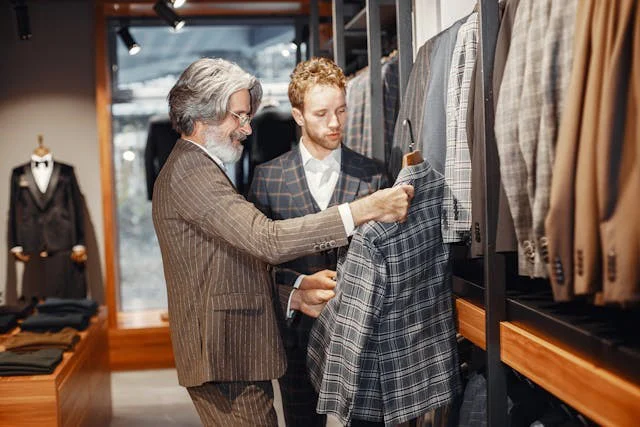 Made To Measure vs Off the Rack: A Complete Comparison Guide
Made To Measure vs Off the Rack: A Complete Comparison GuideDeciding between made to measure suits and off the rack design is not an easy task. But fear not well-groomed gentleman, let’s explore the tailoring field.
No matter who are your targeted clients, it is critical to know the strengths and weaknesses of each variant. Therefore, let’s tear the fabric of confusion apart and sew a couple of the perfect suit solutions right for you.
Made to measure Suits
How MTM Suits Are Crafted
Picture yourself stepping into a tailor shop, where the tailor designs every inch of the suit you will wear specifically for you. That is what makes a Made to measure (MTM) suit unique and the best for its punctilious owner. It’s not about following some pre-existing plan; it is about making a plan that serves personal needs perfectly.
The process begins by measuring different parts of the body to ensure they are captured accurately. They take these measurements to ensure the suit fits a human model by adjusting a standard suit to match the human body shape.
The one thing that makes MTM suits shine is the possibility of personalization. Customers will decide on the type of fabric. Furthermore, they get to choose appearance features such as styles, lapels, pockets, and buttons. Because the suit is custom-made to a person’s dimensions, it would normally need a couple of fittings.
Pros
- Better Fit Through Customization: MTM suits offer a better fit than any other ready-to-wear suits in the market. They give customers the perfect fitting; enhance their body figure and make them appear smart.
- Choice of Fabrics and Styles: MTM means one is not confined to what they see on the rack. You have relative liberty in the type of fabric and style. You can have a suit that perfectly fits your personality.
- Enhanced Comfort: Designers create MTM suits to follow your body movements, ensuring you feel comfortable. No more struggling with a jacket that limits your free movement due to poor stitching.
Cons
- Higher Cost Than Off-the-Rack: Quality comes with a price and so does customization. MTM suits are of course more costly than a ready-made suit grown from the rack.
- Longer Wait Time: Because the suits are custom-made, customers can only get their suits after several weeks, or even months. This can be a disadvantage if one doesn’t have enough time.
- Limited Availability of MTM Services: It’s often rather difficult to identify a good supplier, who would also provide MTM services.
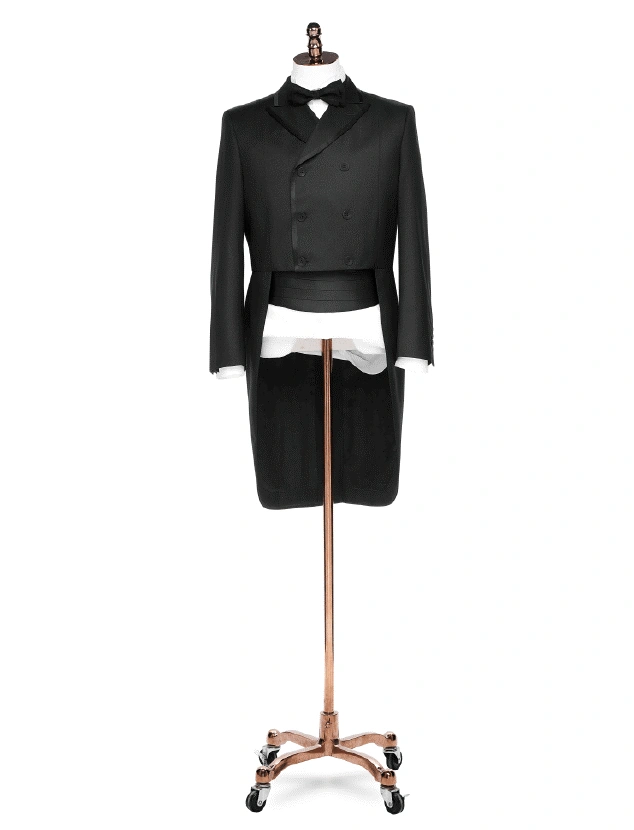
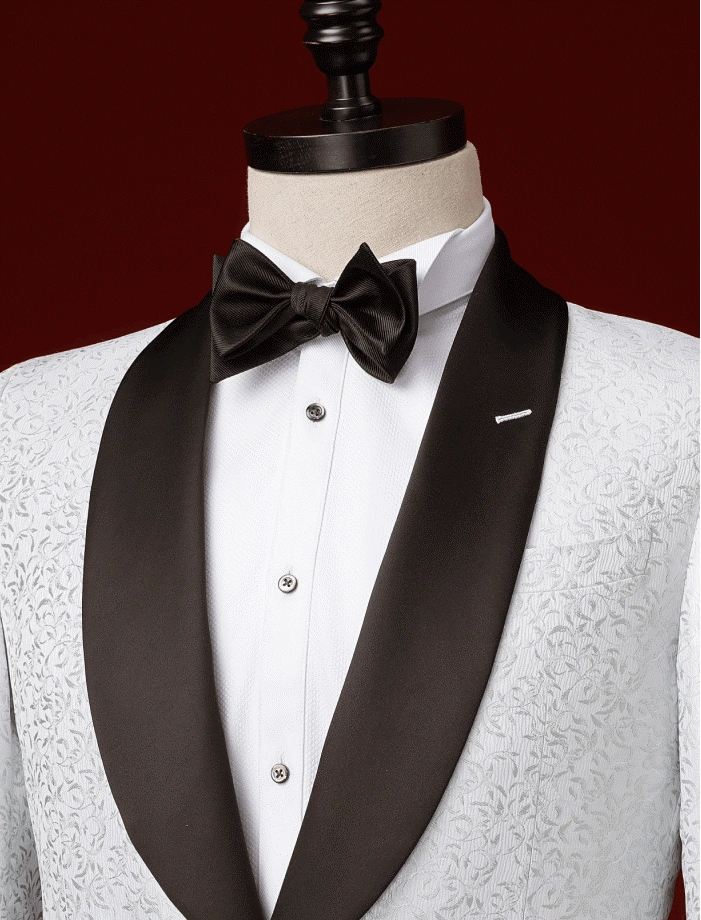
Off-the-Rack Suits
How Off-the-Rack Suits Are Made
In the comparison between off the rack and made to measure, the latter offers quick fixes, easy, and no fuss. Manufacturers make these suits in bulk, cutting and sewing patterns designed to fit various body types. Designers don’t fill their shops and boutiques with these suits, only for them to be purchased, worn once or twice, and then returned to the stores.
Although there is nothing wrong with wearing off the rack suits since they are ready-made, they are not as well-fitted as MTM ones. The designs and fabrics are pre-selected; there won’t be such options as ‘create your T-shirt’ etc. But they prove handy when someone needs to rent a suit in a hurry or is cash-restricted.
Pros
- Affordability: Between made to measure vs off the rack, the latter is consistently cheaper than MTM suits.
- Convenience and Immediate Availability: If one needs a suit in a hurry then nothing can beat the off the rack clothes. Just like many other clothes, customers go to a store, select some, and walk out with their suits. Customers don’t need to wait for longer times.
- Wide Range of Styles: Ready-made suiting is available in different models ranging from the traditional model to the recent fashions.
Cons
- Limited Customization: Manufacturers cut ready-to-wear suits to accommodate as many customers as possible. So, there will always be some issues with either the size or the cut of the garment.
- Fit Issues for Various Body Types: Not all people can wear standard sizes. When it comes to your body shape it is likely that you still cannot get a perfect fitting suit from the standard sizes. This might mean splurging on tailoring – or compromising with the right size and length.
- Potentially Lower Quality Materials: To make them cheaper, off the rack suits can be made from substandard material. This may be a big problem if one is looking to wear the suit on and off.
Differences Between Made to Measure Vs. Off the Rack
1. Fit and Comfort
The biggest made to measure vs off the rack comparison is that fit is where MTM suits work best. They are made according to certain measurements, making them fashionable and fitting at the same time. Retailer suits, on the other hand, come in stock sizes for different categories of people’s sizes, and may not be as comfortable. Of course, you can alter them, but they will never hug you the way a MTM suit will.
2. Customization
MTM suit means that you have an opportunity to decide on everything – the type of fabric, its color, the type of lapels, the number of buttons, etc. One can come up with a suit that caters to their personality and is part of the dress code. Readymade suits therefore allow little choice and one may have to go with a design that may not be what they’ve wanted but is very close to it.
3. Price Range and Value
Although MTM suits cost more than off-the-shelf suits, they offer more value due to their custom fit, superior comfort, and better quality. However, those who want to use a suit for a long time can justify the extra amount charged for a MTM suit. When it comes to wearing readymade suits, these are relatively cheaper than bespoke suits. They may alter a little but the lowest quality fabric may not last as long as one would wish it to.
4. Time Investment
Preparing a MTM suit takes much more time compared to buying a suit off the shelf. MTM-fitted garments require several fittings and adjustments and can take several weeks or even months. However, one may find tailor-made suits less accessible and more expensive compared to off-the-shelf suits, which are easy to find and purchase.
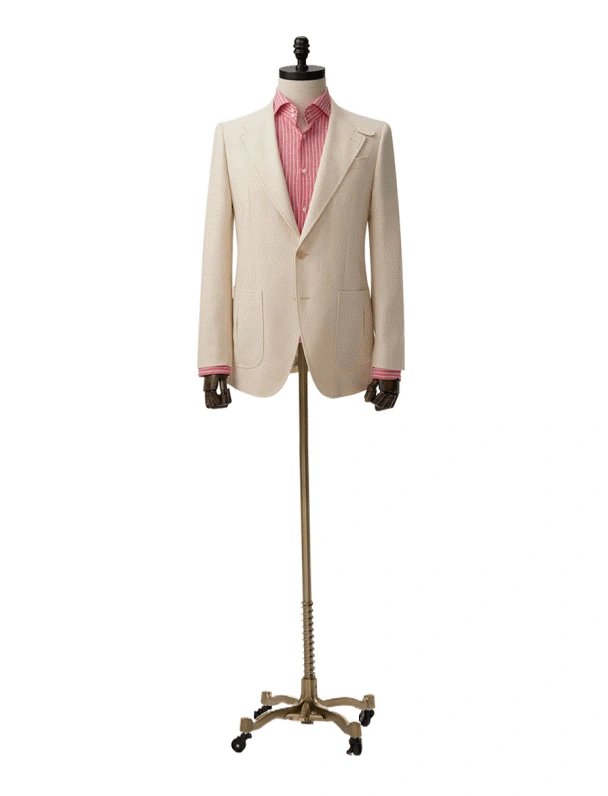
Choosing the Right Suit: Factors to Consider
Personal Style and Preferences
Arguably the most crucial issues to discuss are style preferences for the outfit. If one knows exactly what they want, then it is better to go for a MTM suit. Since customers can choose the type of cloth, cut, lining, and all other aspects of their suits, they will be able to have one that reflects their personality. On the other hand, for embodying the traditional match of pants and jackets, ready-to-wear would do good.
Body Shape and Fit
Consider the body type while debating between MTM suits and ready-made suits. MTM suits perfectly suit anyone with an unusual body shape since tailors make them to body measurements.
For those who have a standard body shape, they only need to make minor adjustments to off the rack suits since manufacturers produce them in ready-made sizes. Nonetheless, if one aims to achieve the best possible fit, then a tailored MTM suit provides much better quality.
Budget Constraints
As much as wearing MTM suits has numerous advantages it has the disadvantage of being expensive. An off the rack suit may suit better if one has limited cash or are short on time. However, one should compare the cost and the usefulness of wearing such a suit – is it justified to spend more money when an ‘ordinary’ MTM suit is available?
Purpose of the Suit
As for a formal event or business-related environment where one needs a smart, well-fitted suit, then it's better to choose an MTM suit or custom formal wear. However, for those who do not regularly attend formal events, it’s totally ok to wear with retail suit.
Takeaways
Kutetailor specializes in the MTM suits. They provide suitable solutions that fit each end-user's needs perfectly and are fully customizable. As a responsible MTM suit provider, Kutetailor ensures that the tailors, fashion brands, and e-commerce sellers that they work with can offer excellent products.
They ensure their products distinguish them from competitors in the market. Kutetailor provides its fit and finish which is much better to off the counter readymade suits with the help of automatic cutting machines and a huge library of pattern data.
FAQ - Made to measure vs off the rack
What is the main difference between made to measure vs off the rack?
The main distinction between made to measure vs off the rack suits is that the former allows more personalization and better fitting. MTM lets you request any style or design, while off the rack suits come predesigned in regular sizes.
Are MTM suits worth the higher cost?
MTM suits are ideal to pay the price when you value fit, customized, and quality. When it comes to a tailor-made suit, it is perhaps pricier than the ready-to-wear ones.
How long does it take to get a MTM suit?
The process of manufacturing a MTM suit may take some time, and it ranges from a few weeks to a few months. This period covers taking measurements, alterations on the pattern as well as fittings so that the garment can fit the client as required.
Can we alter off the rack suits for a better fit?
Indeed, one can employ various techniques to try and make the suits better fit the wearer even if they are bought off the shelf. Some of the usual adjustments include hemming trousers, altering the sides of the jacket, and adjusting the sleeves.
MORE 2024-08-27 -
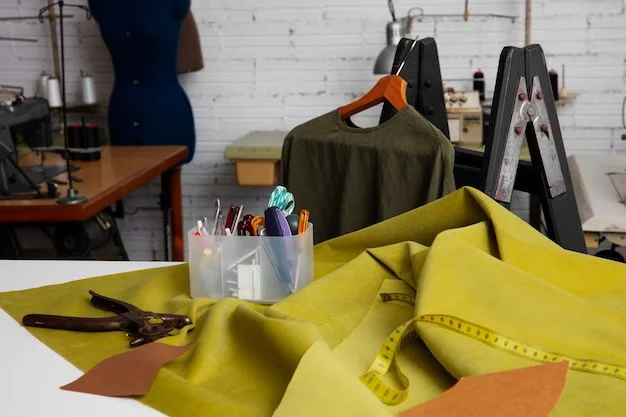 A Close-Up in Custom Clothing: How Does It Cater to All Body Shapes
A Close-Up in Custom Clothing: How Does It Cater to All Body ShapesIn the dynamic fashion world, the apparel industry is continuously evolving to meet customers' diverse and shifting demands. One challenge customers face is finding clothing that fits well across a wide range of body shapes and sizes. It is extremely frustrating to go to a retail shop, sift through the racks, and find a dress you like, only to discover that it isn't available in your size.
Custom clothing is the solution to your problems and offers a tailored approach to accommodate diverse body shapes. Whether the person is tall, petite, broad, or somewhere in between, custom clothing is designed especially for you. In this article, we’ll explore how custom clothing can cater to all body shapes, helping everyone feel confident, comfortable, and truly themselves in their wardrobe.
The Custom Clothing Process: Step-by-Step
Consultation and Design
It all starts with your idea for your garment. For that, you have a friendly consultation where you’ll share your ideas, preferences, and style inspirations. After discussing your ideas and receiving guidance from the designer, you select the fabrics, colors, and design details to create a garment that truly reflects your personality.
Measurement and Fitting
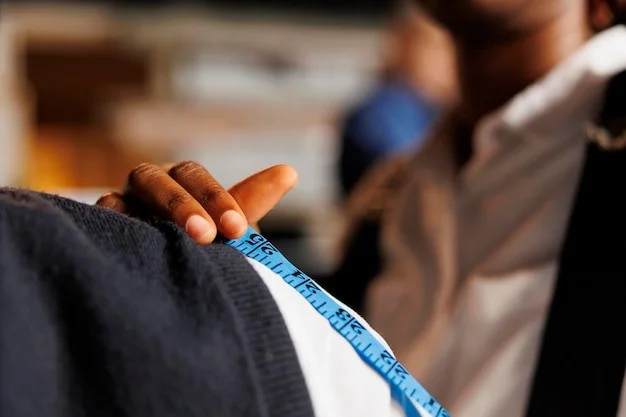
Next is the fitting phase, where precise measurements are taken to ensure a perfect fit. This stage is important as only standard sizes are available in off-the-rack garments. So, here, you can create a piece that feels like it was made just for you. You will work with the designer to ensure every detail is accounted for so the garments fit your body perfectly.
Pattern Making
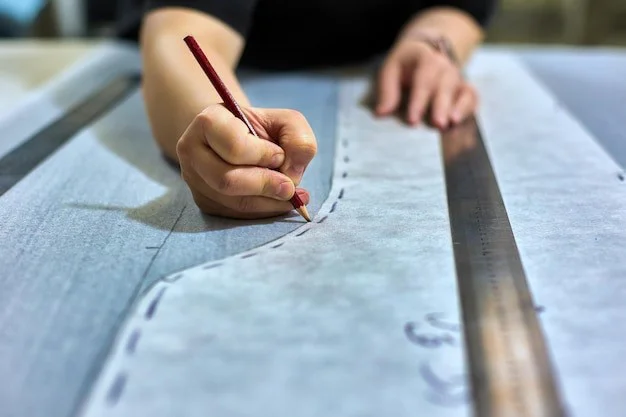
With your measurements in hand, it’s time for a bit of magic: creating the pattern! Think of the pattern as a blueprint for your garment. It’s like a special guide that tells the fabric how to fit and flow perfectly with your shape. The pattern maker will draft the paper pattern to match your dimensions and requirements. You can make any modifications to this pattern.
Cutting and Construction
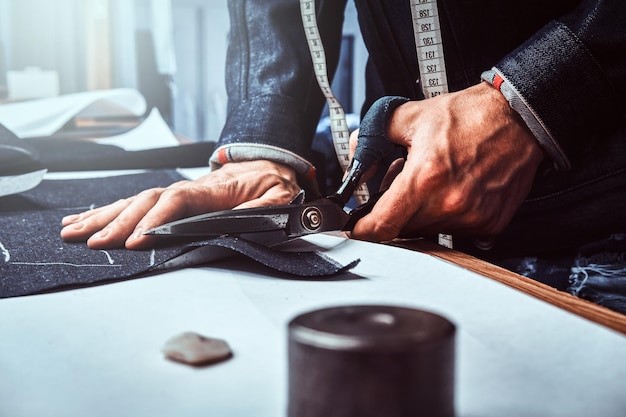
With your custom pattern ready, comes the next step, which is when the process of turning your dream into reality starts. Skilled artisans follow the personalized blueprint crafted by the pattern maker, executing precise stitching at every seam and curve. Then, the real magic happens as skilled artisans begin sewing and assembling your garment, each piece with care and great attention to detail. This is where your garment starts to take shape.
Fitting Sessions and Alterations
Once the initial construction is complete, it is time for fitting and alterations sessions. During these sessions, the designer makes sure everything fits just right, adjusting anything that needs a little tweak. Whether it’s taking in the waist, adjusting the length, or perfecting the shoulders, they adjust the garment ensuring it fits perfectly on your body.
Final Touches and Delivery
Once the garment is nearly complete, the designer adds the final touches to elevate its appearance. Small details like adding those perfect buttons, finishing the seams, or giving the fabric a final press bring everything together.
Once every element is perfect, your personalized garment is delivered, ready for you to enjoy and showcase your unique style.
How Custom Clothing Caters to All Body Shapes
Personalized Fit
Unlike standard-sized apparel, custom clothing offers a personalized fit and is tailored specifically to your measurements. Off-the-rack clothes are made to fit a general size range, while custom clothing can accommodate your specific proportions. Hence, each clothing item fits perfectly and complements your body shape.
Design Flexibility
With custom clothing, you have the flexibility to choose designs that suit your unique style and requirements. Whether you prefer a particular cut, fabric, or detail, you can personalize every aspect of your garment to match your personal taste. The final garment not only compliments your body but also reflects your unique style.
Enhanced Comfort
A well-fitted suit delivers comfort with precise measurements. The body moves with the garment rather than against it, providing an exceptional level of comfort and ease. By aligning each garment with your unique body shape, custom clothing minimizes common issues such as gaping, bunching, and restrictive areas. Custom clothing is also functional and supports your daily activities with optimal comfort.
Addressing Common Fit Issues
Off-the-rack clothes have generalized sizes, so one common issue customers face is gaping or looseness, particularly at the neckline or around the waist. Custom clothing addresses this by fitting your exact measurements, eliminating gaps, and ensuring a secure, tailored fit.
Another problem is bunching and wrinkling, which can arise when garments do not align well with your body shape. Since custom clothing is constructed by taking precise measurements at various angles, it results in a smooth, clean appearance.
Moreover, there are limited styling options in ready-made dresses. Custom clothing allows you to select every detail, from fabric and color to design elements. This personalization ensures your garment fits well and reflects your personal style.
Additionally, many off-the-rack items require alterations to achieve a proper fit, but custom clothing eliminates the need for frequent adjustments by providing a perfect fit from the outset, saving time and effort.
Challenges of Custom Clothing
Time and Cost Investment
The process of creating bespoke clothing involves various stages, from design discussion to drafting a pattern to modification to final stitching. This is a time-intensive process, as artisans meticulously oversee each step, ensuring that no detail is overlooked. That is why there is a longer wait time in the delivery of customized garments. Moreover, the fabric used is also premium, hence the price is on the higher end.
This detailed and personalized approach results in a higher cost and longer wait time, which may not be suitable for everyone, especially for those seeking quick or budget-friendly solutions.
Skilled Manufacturer
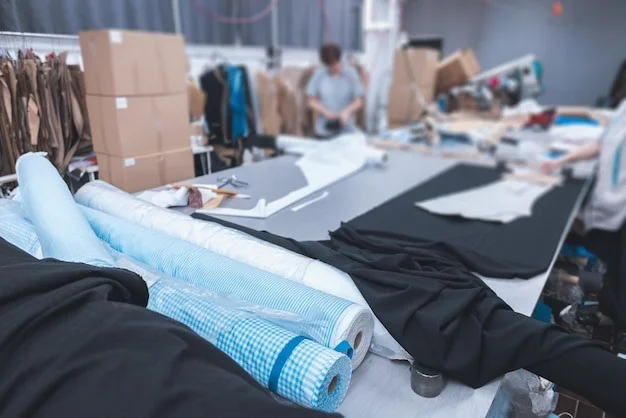
The quality of custom clothing heavily depends on the expertise of the manufacturer. Identifying a skilled tailor or designer capable of translating your vision into a finely crafted garment is crucial. Not all manufacturers offer the same level of craftsmanship, and selecting the right one is essential to ensure the final product meets your fit, design, and quality expectations.
Balancing Trends with Personal Style
Custom clothing provides the opportunity to create a unique and personal wardrobe. However, this customization can sometimes create challenges in balancing current fashion trends with individual style preferences. While custom garments allow for personalized design, staying current with evolving trends while maintaining a timeless personal style requires careful consideration and collaboration with your tailor or designer.
Innovative Solution from Kutetailor
Custom clothing is the ultimate solution for addressing the diverse needs of all body shapes, offering a personalized fit, design flexibility, and enhanced comfort. Each garment is designed to take an individual’s exact measurements and preferences, hence custom clothing solves common fit issues and provides a unique blend of style and function.
Kutetailor is a top custom apparel manufacturer and offers streamlined processes in the making of personalized garments. Kutetailor’s digital platform significantly reduces lead times through its seamless ordering process and real-time tracking capabilities. This technology not only simplifies the management of custom clothing businesses but also enhances the overall customer experience of made to measure suits online. By leveraging such advancements, both businesses and customers can enjoy the benefits of bespoke fashion with greater efficiency and ease, making custom clothing more accessible and responsive to modern demands.
FAQ
How does custom clothing ensure a perfect fit for all body shapes?
Each custom garment is tailored to meet your specific measurements thus achieving a perfect fit. These clothes are designed to fit your body perfectly unlike the standard sizes that may fail to accommodate your body proportions.
Can I incorporate current fashion trends into my custom clothing while maintaining my style?
Yes, custom clothing allows you to mix and match current fashion trends with your personal sense of style. You can select trendy fabrics or features that suit your taste while maintaining an overall design in accordance with your individual style, hence adding value and uniqueness to the garment.
What types of common fit issues can custom clothing resolve?
Custom clothing can address various fit issues, such as gaping, bunching, and uncomfortable tightness. By tailoring garments to your precise measurements, you ensure a smooth, flattering fit that avoids the common problems associated with off-the-rack clothing.
MORE 2024-08-23 -
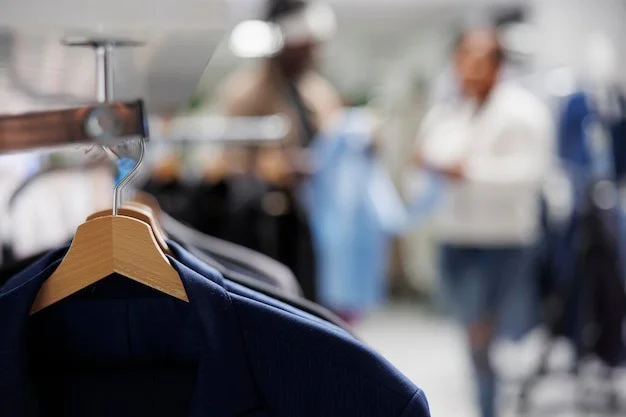 How to Choose the Right Custom Clothing Manufacturer
How to Choose the Right Custom Clothing ManufacturerIt is very crucial to select the best custom clothing manufacturer as it can make or break any business of customized clothes. Custom clothing is a diverse market that spans various segments, including luxury, corporate, and specialized apparel. All of these depend heavily on quality, innovation, and customization. Therefore, the right manufacturer who is experienced enough to interpret your vision in a production-friendly way can help your brand stand out in a competitive market.
Moreover, the right manufacturer simplifies production, which lowers costs and boosts the success of your business. This article will guide you in choosing the custom clothing manufacturer, helping you make an informed decision that will boost your brand's reputation and production line.
Identifying Your Needs and Goals
Before searching for a custom clothing manufacturer, you must clearly define your business's needs and goals. Consider factors like the type of products you want to create, the scale of production, and the overall aesthetic you wish to maintain. This will help you narrow down your options and find a manufacturer that can meet your specific demands.
Product Requirements
If you wish to start a custom clothing line, you must determine your business's product requirements. Decide whether you want to create high-end products, custom men’s casual wear, custom women’s clothing, or specialized clothing. If you decide on these requirements beforehand, it will be easier for you to find the manufacturer with the expertise and resources to meet them.
Additionally, you should consider the kind of clothes you want to produce, the materials needed, and any special features or details significant to your brand. This will enable you to evaluate the manufacturer's capacity in terms of production methods, quality control, and their ability to source appropriate fabrics and materials.
Target Market
You should identify a target market where you will sell your clothing line. Understand what the target market wants and expects from sellers and how their buying habits will affect the type of clothing you produce and the manufacturer you choose.
The research will show whether your audience values sustainability or trendiness. Either they are looking for clothing that is luxurious or affordable. The right manufacturer understands your market and can help you create products that resonate with your customers and stand out in the marketplace.
The Level of Customization
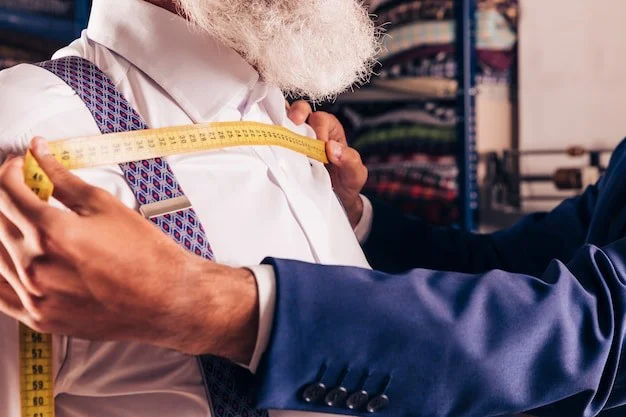
In custom clothing, the biggest unique selling point of any fashion brand is the level of customization it offers. Some brands provide full bespoke services with every little detail created from scratch, while others might only need minor adjustments to existing designs. Therefore, while selecting a manufacturer, it is important to assess whether the manufacturer can provide the level of customization you need, from pattern making and fabric selection to embroidery, printing, and packaging.
Researching Potential Manufacturers
Industry Experience and Expertise
The first thing to consider when researching potential suppliers is a custom clothing manufacturer's industry experience and expertise. Most likely, a manufacturer that has been producing custom clothes for years knows how to do it better than anyone else. It is more than just an accumulation of skills, in fact, it is about getting insights into market trends, developing powerful relationships with suppliers, and building strong capabilities in areas like sourcing and manufacturing.
Additionally, if you are focusing on niche markets such as high-end, activewear, eco-friendly, or cost-effective apparel, you must ensure your manufacturer fully understands the unique challenges and requirements of your product line.
Reputation and References
Another important aspect to consider is the manufacturer's reputation. Look for a manufacturer with a positive brand name and a strong reputation in the market. You can also check out other company reviews regarding the manufacturer. A manufacturer with a strong track record and satisfied clients is more likely to be a trustworthy partner for your business.
When you look into past records and reviews of the manufacturer, you can get a clear idea about the performance capabilities, which will be greatly helpful in selecting the right manufacturer.
Evaluating Manufacturing Capabilities
It is important to assess the manufacturer's abilities comprehensively. Therefore, having a complete understanding of these factors would help determine whether this manufacturer could produce goods that meet your brand’s requirements in terms of quality and efficiency.
Quality Control Processes
Quality matters the most in custom clothing. The standard of quality must be maintained in all the processes, from the initial sourcing of material to the final packaging. While selecting a manufacturer, you can evaluate the quality control measures taken by the manufacturer. A reliable manufacturer must ensure testing for fabric durability, color consistency, stitching accuracy, and overall garment construction.
A manufacturer who focuses on quality is helpful for your future business as effective quality control processes help minimize defects, and reduce waste, leading to the final products that meet both your standards and customer expectations.
Technology and Equipment
The fashion industry has evolved drastically due to the implementation of technology. The innovation of the production process has allowed businesses to offer higher quality products at a consistent level.
While looking for a manufacturer, select the one that invests in modern technology. A manufacturer that has advanced machinery for cutting, sewing, printing, and embroidery as well as digital tools for design and pattern making can make your business more quality-driven. Additionally, the use of automated processes can lead to faster production times with the ability to handle complex or customized orders.
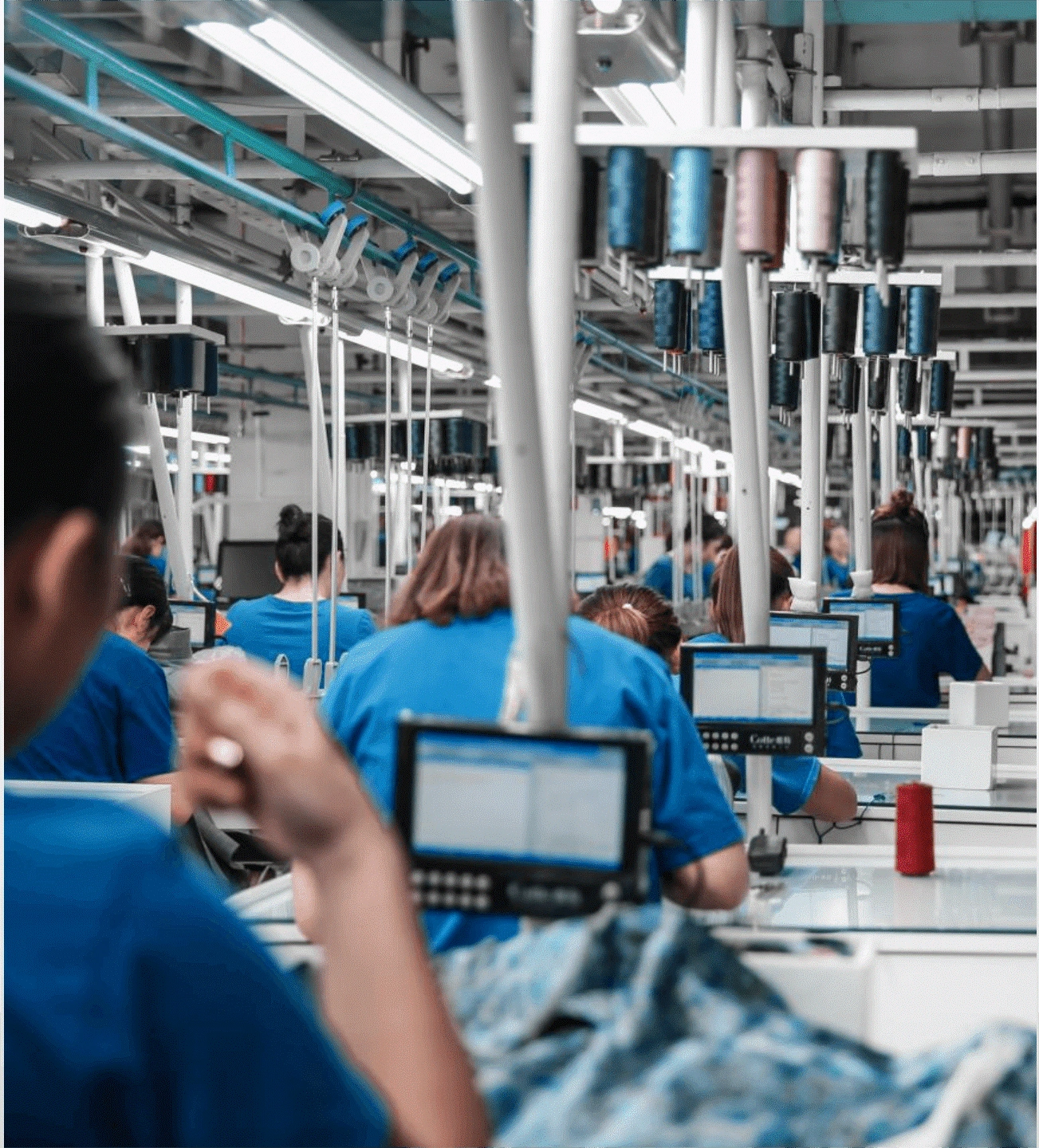
Sustainability and Ethical Practices
In today's market, sustainability and ethical practices are increasingly important factors for consumers and businesses alike. One way to enhance your brand image is by partnering with manufacturers who prioritize eco-friendly operations and ethical labor practices. This will help you to appeal to an ever-growing segment of conscious buyers.
When evaluating a manufacturer, inquire about their use of sustainable materials, waste reduction practices, and energy efficiency initiatives. Additionally, ensure that the manufacturer follows fair labor standards and provides safe working conditions and fair wages to its employees.
Cost and Pricing Structures
Budget Considerations
Your budget is one of the most important factors in choosing a manufacturer. It's essential to find a manufacturer that can deliver the quality you need at a price that fits within your financial constraints. When assessing costs, consider not just the base price per unit but also additional costs such as shipping, duties, and potential rush fees for quicker turnaround times.
Some manufacturers may offer services at a lower rate but keep in mind that while lower costs might be appealing, they should not come at the expense of quality.
Minimum Order Quantities (MOQs)
For any small business, Minimum Order Quantities (MOQs) are a key consideration when selecting a manufacturer. MOQs refer to the smallest number of units a manufacturer is willing to produce in a single order. When a manufacturer has high MOQs, it becomes challenging for businesses with limited budgets.
When choosing a manufacturer, ensure that their MOQ requirements align with your production needs and financial capabilities.
Design and Development Support
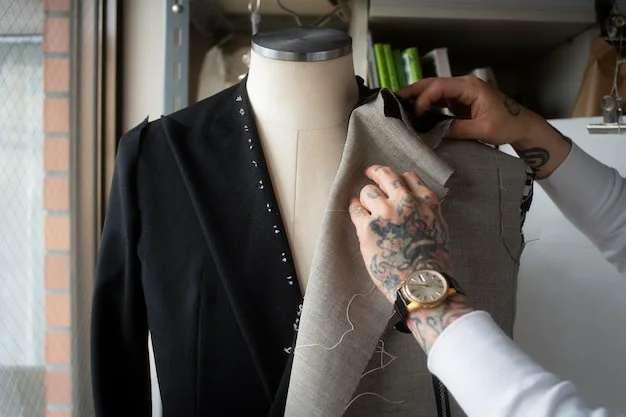
Design and development support is crucial for custom clothing businesses aiming to bring unique ideas to life. Manufacturers offering custom design and prototyping services can help refine your concepts, develop precise patterns, and create prototypes that ensure your designs are market-ready. This collaboration allows for adjustments before full-scale production, reducing errors and saving time. Partnering with a manufacturer that provides these services ensures your final product aligns with your vision and maintains high-quality standards.
Kutetailor: Your Ideal Custom Clothing Manufacturer
When it comes to selecting the right custom clothing manufacturer, you can trust no other than professional and experienced custom clothing partner Kutetailor, a specialized custom clothing manufacturer to enhance your business. It is a one-stop platform that offers an outstanding range of services for all your custom-made apparel needs.
Offering custom design assistance and cutting-edge manufacturing expertise, Kutetailor has a commitment to high standards. Without the MOQ, Kutetailor is an ideal choice for startups and small brands. Whether you are starting a new brand or taking your existing one to the next level, Kutetailor has got all that it takes to be competitive in fashion.
MORE 2024-08-21 -
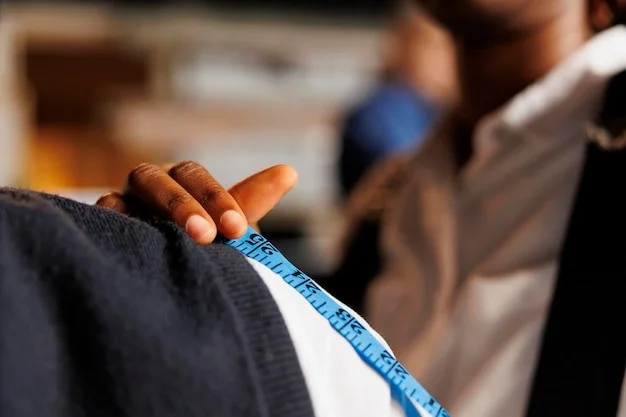 Made to Measure vs. Bespoke: Features & Differences
Made to Measure vs. Bespoke: Features & DifferencesIn men’s fashion, a well-fitted suit reflects quality and is a lifelong investment. Custom tailoring has been around for ages. It offers a personalized fit and unique style that distinguishes it from off-the-rack suits. However, there are various menswear options in custom clothing, like bespoke and made-to-measure. These categories are often confused as one, and not everyone knows the difference between them.
In this article, you will uncover the different features of bespoke and made-to-measure suits and understand the difference between the two.
Made to Measure
It is a type of custom tailoring that uses a basic or standard pattern, usually bought off the rack. The tailor then takes your measurements and adjusts the pattern accordingly. Unlike ready-to-wear suits, which come in standard sizes, MTM suits (both made to measure men's suits and women's) are made after taking specific measurements.
Key Features
- Customization ensures a better fit than off-the-rack suits but does not involve creating an entirely new pattern.
- Customers can usually choose fabrics, linings, buttons, and specific style details, such as lapel shape and pocket style.
- The turnaround time is generally faster, and suits are usually completed within a few weeks.
- An affordable option for those seeking a custom-fit suit without the higher price tag.
- Less labor and extensive work, as some parts of the suit are machine-stitched.
Bespoke
Bespoke tailoring is the highest level of tailoring, where a suit is crafted entirely from scratch. Unlike off-the-rack or made-to-measure options, bespoke suits create a unique pattern, ensuring a perfect fit. There are no base patterns, and the tailor starts with a black canvas, designing everything from scratch.
Key Features
- A unique and completely new pattern is created from scratch based on your precise measurements.
- There is an unlimited customization option where every detail of the suit can be personalized.
- The major portion of the suit is hand-stitched. Hence, the quality and craftsmanship are superior.
- Multiple fitting sessions are conducted to ensure a flawless and perfect fit.
- Premium materials are used.
- Due to extensive customization, handcrafting, and premium materials, bespoke suits are a luxury investment.
Fit
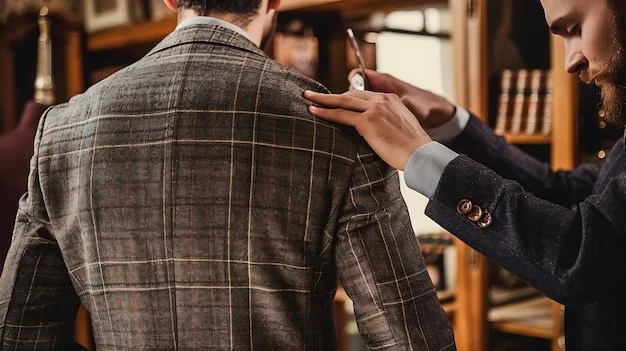
Made to Measure
For MTM, the alterations are usually made in the off-the-rack suit. However, the tailor requires detailed measurements from every angle of the wearer’s body. Therefore, obtaining the dimensions and designing a draft usually takes one or two fittings. A final fitting ensures the suit fits perfectly according to your body’s measurements.
Bespoke
In bespoke suits, everything from the fabric to the design to the measurements is from scratch without any pre-set pattern. Therefore, more measurements are required than in MTM suits.
Bespoke tailoring typically involves 3-5 fitting sessions throughout the suit-making process. This includes an initial "baste" fitting where the suit is loosely or temporarily stitched with basting thread.
Further fittings take place to reach a level of refinement. The tailor wants to ensure the garment fits the client perfectly.
Customization
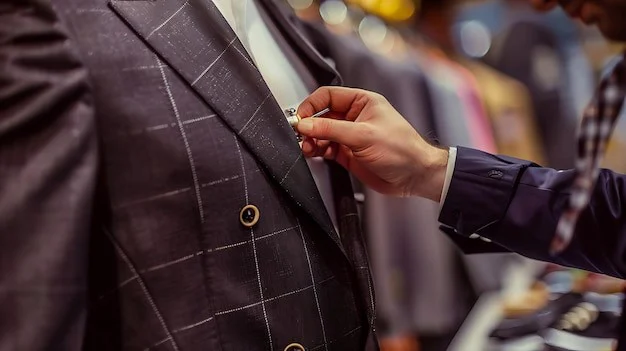
Made to Measure
Made to Measure offers a variety of customization options. You can choose the jacket vent, linings, lapel style, and collar style. In accessories, you can select the number of buttons you want, the pocket and cuff style you need, and the trouser waistband style.
But keep in mind that customization options are limited compared to bespoke. The suit is adjusted to your measurements, and customization in terms of fit is limited to an existing pattern. The ability to modify aspects like the shoulder width or chest drape is constrained by the original pattern.
Bespoke
With bespoke tailoring, the customization options are limitless. You can select fabric from an unlimited variety of fabrics and have your suit made with rare and luxurious materials. Moreover, there is a huge variety of colors, patterns, and textures.
Furthermore, every aspect of the suit’s design can be customized to your preference. This includes unique lapel shapes, pocket styles, button placements, jacket lengths, and more. The tailor can accommodate virtually any request, creating a unique suit.
Quality
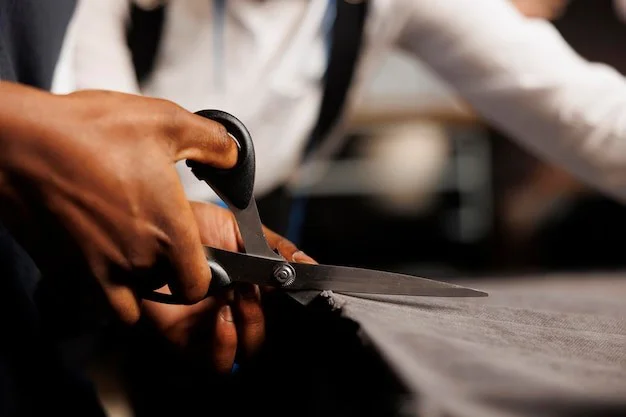
Made to Measure
Made to Measure (MTM) suits offer a significant upgrade over off-the-rack options, such as blending machines and hand stitching to create a high-quality garment. MTM suits are made with good to high-quality fabrics and provide a very good fit. However, the construction and finish are somewhat standardized, reflecting a balance of quality and affordability. The use of machine stitching and standard techniques, while efficient, may result in a slightly less durable suit compared to bespoke options.
Bespoke
Bespoke clothing is a statement of exceptional quality and longevity. Every piece is hand-stitched by skilled artisans with different measurements and fit-check sessions. The fabric selection is premium, with access to the finest and most exclusive materials, resulting in a suit that fits perfectly and reflects elegance and sophistication. Due to the superior materials and expert craftsmanship, bespoke suits are highly durable and can last decades with proper care.
Cost Considerations
Made to Measure
MTM is a combination of bespoke and off-the-rack. It is cheaper than bespoke but pricier than off-the-rack suits. MTM offers a balance between cost and customization. The lower price point is due to standardized patterns and a combination of machine and hand stitching, which streamlines the production process.
Bespoke
Bespoke suits are made from a pattern designed from scratch. Each piece is unique, made with premium materials and expert hand-stitching. Moreover, artisans spend long hours creating each custom suit. The price is actually the hard work, time, and premium materials used. Moreover, it is a long-term investment due to its unparalleled quality and durable finish.
Choosing the Right Option
When choosing between Made to Measure (MTM) and Bespoke tailoring, it's important to consider your budget and the level of customization you want.
MTM suits offer a good fit and quality at a lower cost. You can choose from different fabrics and styles, but the options are more limited compared to bespoke. MTM is a solid option if you desire a tailored suit without spending too much money.
They are expensive because they involve lots of handwork, top materials, and several fitting sessions. With bespoke, you get a suit designed specifically according to your requirements, reflecting your individuality. If money is not an issue and you would like a truly unique suit that fits perfectly on your body, then choose a bespoke one.
Think about what matters most to you—fit, quality, or cost. MTM suits take less time to make, while bespoke suits may take longer but offer the best customization and craftsmanship.
Conclusion
Both Made-to-measure (MTM) and bespoke suits have their benefits depending on preferences. MTM provides outstanding value and a customized fit at affordable pricing, making it ideal for people seeking custom clothing without breaking their bank accounts. On the other hand, bespoke suits deliver unmatched craftsmanship, personalization, and a perfect fit, though they come with a higher price tag and longer production time.
For those seeking the best of both worlds, Kutetailor is an ideal choice. They provide choices in both MTM and Bespoke, enabling a flexible level of customization. Whether you opt for the business of MTM suits or the unparalleled excellence of bespoke garments, Kutetailor provides expert tailoring services to support your business.
FAQ
What is a Bespoke Pattern?
A bespoke pattern is a custom-made template created from a client’s precise measurements. Unlike standard patterns, it is tailored to the individual’s body shape and preferences. This ensures a perfect fit and personalized style, resulting in a garment uniquely suited to the client’s physique.
What is the difference between bespoke and RTW suits?
Bespoke suits are custom-made from scratch with a unique pattern for each client, offering a perfect fit and extensive personalization. RTW (Ready-to-Wear) suits are pre-made in standard sizes and available off-the-rack, providing less customization and fit but at a more affordable price.
How long will a bespoke suit last?
Made with high-quality materials, expert craftsmanship, and great attention to detail, bespoke suits are durable and can last 5-10 years, depending on the frequency of wear.
MORE 2024-08-14

